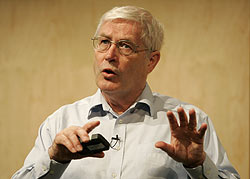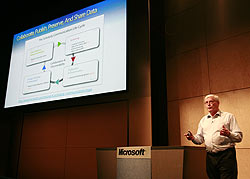REDMOND, Wash. — July 28, 2008 — At the ninth annual Microsoft Research Faculty Summit today, leaders from Microsoft Research outlined their vision for how Microsoft Corp. and academics can collaborate on research projects to develop technological breakthroughs that will define computing and scientific research in the years ahead.
Speaking to more than 400 faculty members from leading research institutions worldwide, Tony Hey, corporate vice president of Microsoft’s External Research Division, emphasized the role his group plays not only in supporting specific collaborative research projects, but also in improving the process of research and its role in the innovation ecosystem, including developing and supporting efforts in open access, open tools, open technology and interoperability. Toward that end, Hey announced a set of free software tools aimed at allowing researchers to seamlessly publish, preserve and share data throughout the entire scholarly communication life cycle. He also discussed collaborative initiatives intended to unlock the potential of multicore computing.

Tony Hey, Corporate Vice President of Microsoft External Research outlines his vision for how the company and academics can collaborate on projects to help define computing and scientific research in the years ahead at the ninth annual Microsoft Research Faculty Summit. Hey leads the company’s efforts to build long-term, public-private partnerships with global academic, industrial, and governmental communities to advance computer science, education, and key areas of scientific research that increasingly rely upon advanced computing. Redmond, Wash., July 28, 2008.
In the area of scholarly communication, Hey said, “Collecting and analyzing data, authoring, publishing, and preserving information are all essential components of the everyday work of researchers — with collaboration and search and discovery at the heart of the entire process. We’re supporting that scholarly communication life cycle with free software tools to improve interoperability with existing tools used commonly by academics and scholars to better meet their research needs.”
Microsoft researchers partnered with academia throughout the development of these tools to obtain input on the application of technology to the needs of the academic community, while Microsoft product groups submitted feedback on how the company’s technology could optimally address the entire research process. The collective efforts resulted in the first wave of many tools designed to support academics across the scholarly communication life cycle.
The following tools are freely available now:
-
Add-ins. The Article Authoring Add-in for Word 2007 enables metadata to be captured at the authoring stage to preserve document structure and semantic information throughout the publishing process, which is essential for enabling search, discovery and analysis in subsequent stages of the life cycle. The Creative Commons Add-in for Office 2007 allows authors to embed Creative Commons licenses directly into an Office document (Word, Excel or PowerPoint) by linking to the Creative Commons site via a Web service.
-
The Microsoft e-Journal Service. This offering provides a hosted, full-service solution that facilitates easy self-publishing of online-only journals to facilitate the availability of conference proceedings and small and medium-sized journals.
-
Research Output Repository Platform. This platform helps capture and leverage semantic relationships among academic objects — such as papers, lectures, presentations and video — to greatly facilitate access to these items in exciting new ways.
-
The Research Information Centre. In close partnership with the British Library, this collaborative workspace will be hosted via Microsoft Office SharePoint Server 2007 and will allow researchers to collaborate throughout the entire research project workflow, from seeking research funding to searching and collecting information, as well as managing data, papers and other research objects throughout the research process.

Tony Hey, Corporate Vice President of Microsoft External Research, announced a set of free software tools to improve interoperability with existing academic research tools. Hey also announced that Microsoft will provide US$1.5 million to seven academic researchers to support research in multicore software. The announcement was made at the ninth annual Microsoft Research Faculty Summit, which brings together 400 academics from 150 universities across five continents. Redmond, Wash., July 28, 2008.
“Technology that effectively addresses the increasing need to integrate the research life cycle and provide a holistic end-to-end perspective has the potential to revolutionize the way academics collect data, publish findings and preserve information,” said Daniel Pollock, vice president and lead analyst at Outsell Inc., a research and advisory firm specializing in the information and education industries. “Companies that work closely with academia can understand how their products might benefit the scholarly workflow and so inform their product development. Microsoft is engaged with the academic community and is releasing a series of tools aimed at streamlining the academic workflow.”
Microsoft External Research has a history of supporting groundbreaking research, supporting approximately 400 research projects worldwide last year alone. One area of particular focus has been parallel computing, as exemplified by the creation of a Joint Research Centre with the Barcelona Supercomputing Center, and two Universal Parallel Computing Research Centers in partnership with Intel Corporation, the University of California, Berkeley, and the University of Illinois at Urbana-Champaign in the past year. Furthering Microsoft’s efforts to unlock the potential of multicore processing, Hey announced that his group will provide $1.5 million to seven academic research projects as part of the Safe and Scalable Multicore Computing Program, with the goal of stimulating impactful research in multicore software.
Under Hey’s leadership, the Microsoft External Research team, which complements the work pursued by more than 800 Microsoft researchers in the larger Microsoft Research organization, accelerates the company’s efforts to build lasting public-private partnerships with global scientific and engineering communities. In collaboration with scientists and researchers from industry, academia and government, the External Research team pursues advances in four important areas of research: computer science; earth, energy and environment; education and scholarly communications; and health and well-being.
More information about the annual Microsoft Research Faculty Summit is available at http://www.research.microsoft.com/workshops/FS2008.
About Microsoft Research
Founded in 1991, Microsoft Research is dedicated to conducting both basic and applied research in computer science and software engineering. Its goals are to enhance the user experience on computing devices, reduce the cost of writing and maintaining software, and invent novel computing technologies. Researchers focus on more than 55 areas of computing and collaborate with leading academic, government and industry researchers to advance the state of the art in such areas as graphics, speech recognition, user-interface research, natural language processing, programming tools and methodologies, operating systems and networking, and the mathematical sciences. Microsoft Research currently employs more than 800 people in six labs located in Redmond, Wash.; Cambridge, Mass.; Silicon Valley, Calif.; Cambridge, England; Beijing, China; and Bangalore, India. Microsoft Research collaborates openly with colleges and universities worldwide to enhance the teaching and learning experience, inspire technological innovation, and broadly advance the field of computer science. More information can be found at http://www.research.microsoft.com.
About Microsoft
Founded in 1975, Microsoft (Nasdaq “MSFT”) is the worldwide leader in software, services and solutions that help people and businesses realize their full potential.
Note to editors: If you are interested in viewing additional information on Microsoft, please visit the Microsoft Web page at http://www.microsoft.com/presspass on Microsoft’s corporate information pages. Web links, telephone numbers and titles were correct at time of publication, but may since have changed. For additional assistance, journalists and analysts may contact Microsoft’s Rapid Response Team or other appropriate contacts listed at http://www.microsoft.com/presspass/contactpr.mspx.




